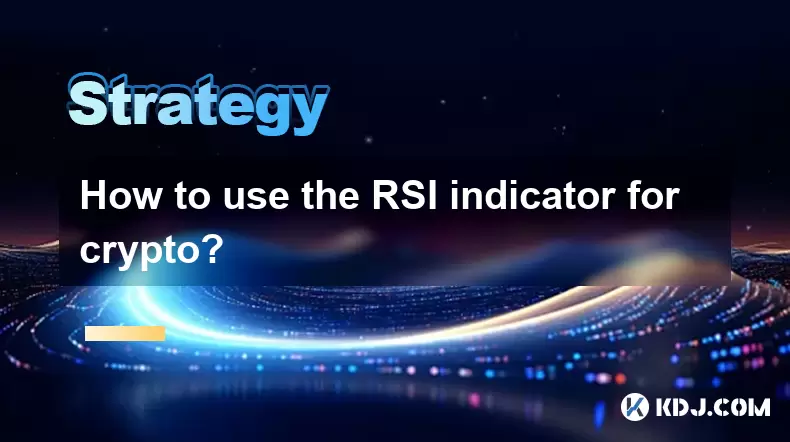-
 bitcoin
bitcoin $118548.520763 USD
3.67% -
 ethereum
ethereum $4352.564943 USD
4.79% -
 xrp
xrp $2.964058 USD
4.22% -
 tether
tether $1.000565 USD
0.05% -
 bnb
bnb $1028.372955 USD
1.46% -
 solana
solana $221.373507 USD
6.00% -
 usd-coin
usd-coin $0.999933 USD
0.02% -
 dogecoin
dogecoin $0.248633 USD
6.85% -
 tron
tron $0.341444 USD
2.38% -
 cardano
cardano $0.852946 USD
5.82% -
 hyperliquid
hyperliquid $47.869306 USD
6.15% -
 chainlink
chainlink $22.561476 USD
6.01% -
 ethena-usde
ethena-usde $1.001258 USD
0.05% -
 avalanche
avalanche $30.660000 USD
2.06% -
 stellar
stellar $0.400917 USD
9.76%
How to use the RSI indicator for crypto?
The RSI indicator helps crypto traders identify overbought/oversold conditions, potential reversals, and entry/exit points by measuring price momentum on a 0–100 scale.
Jul 12, 2025 at 03:56 pm

Understanding the RSI Indicator in Cryptocurrency Trading
The Relative Strength Index (RSI) is a momentum oscillator used to measure the speed and change of price movements. In the context of cryptocurrency trading, RSI helps traders identify overbought or oversold conditions, potential trend reversals, and entry or exit points. It operates on a scale from 0 to 100, with levels above 70 typically indicating overbought conditions, and levels below 30 signaling oversold conditions.
It’s important to note that while RSI can provide valuable insights, it should not be used in isolation. Combining RSI with other technical indicators such as moving averages or volume analysis enhances its effectiveness in crypto trading strategies.
Setting Up RSI for Crypto Charts
To use RSI effectively, traders must first know how to set it up on their preferred charting platform. Most platforms like TradingView, Binance, or CoinMarketCap allow users to add RSI directly to their charts.
- Open your chosen charting tool or exchange platform that supports technical analysis.
- Navigate to the 'Indicators' section, usually found at the top or side of the chart interface.
- Type 'RSI' into the search bar and select the Relative Strength Index indicator.
- Adjust the default settings if necessary—most platforms use a 14-period setting, which is suitable for most crypto assets.
- Click 'Add to Chart' or apply the changes to visualize the RSI beneath the price chart.
Choosing the right time frame is crucial when applying RSI to cryptocurrencies. Short-term traders may prefer using RSI on 15-minute or 1-hour charts, while long-term investors might rely on daily or weekly charts.
Interpreting RSI Levels for Overbought and Oversold Signals
One of the primary uses of RSI in crypto trading is identifying overbought and oversold conditions. When the RSI line crosses above 70, it suggests that the asset may be overbought and due for a pullback. Conversely, when RSI drops below 30, the asset may be oversold and poised for a rebound.
However, due to the volatile nature of cryptocurrencies, these thresholds can sometimes lead to false signals. For instance, during strong uptrends, RSI may remain above 70 for extended periods without any significant correction.
- Monitor RSI levels consistently across multiple candlesticks to confirm trends.
- Use additional tools like Bollinger Bands or MACD to validate RSI readings.
- Avoid making trades solely based on RSI crossing 70 or 30 unless supported by volume or price action confirmation.
Experienced traders often adjust the standard RSI thresholds depending on market conditions. Some may use 80 and 20 for highly volatile coins like altcoins.
Spotting Divergences Using RSI
Divergence occurs when the price of a cryptocurrency moves in one direction, but the RSI moves in the opposite direction. This can signal a potential reversal in the current trend.
For example, if Bitcoin's price makes a new high, but the RSI fails to surpass its previous high, this could indicate weakening momentum and an impending bearish reversal.
- Draw trendlines connecting highs and lows on both the price chart and RSI line.
- Look for inconsistencies between the direction of the price movement and RSI movement.
- Confirm divergence with a candlestick pattern or support/resistance level break.
Divergence patterns are more reliable on higher time frames like the 4-hour or daily chart. Traders should avoid acting on divergence alone without confirming signals from other tools.
Incorporating RSI with Other Indicators for Better Accuracy
Using RSI alongside complementary indicators improves trade accuracy and reduces the likelihood of false signals. A popular combination includes RSI with the Moving Average Convergence Divergence (MACD) or Simple Moving Averages (SMA).
- When RSI indicates oversold conditions and the MACD line crosses above the signal line, it can signal a bullish opportunity.
- Conversely, if RSI shows overbought levels and the MACD line crosses below the signal line, a bearish move may follow.
- Adding volume indicators like On-Balance Volume (OBV) can help confirm whether a trend is supported by strong buying or selling pressure.
Traders should backtest their combined strategy before applying it live. Historical data testing ensures that the strategy works under various market conditions.
Frequently Asked Questions (FAQs)
Q: Can RSI be adjusted for different cryptocurrencies?Yes, RSI can be customized depending on the volatility and behavior of each cryptocurrency. While the default period is 14, some traders may reduce it to 7 or 10 for faster signals or increase it to 21 for smoother results.
Q: How does RSI behave in sideways markets compared to trending ones?In sideways or range-bound markets, RSI tends to oscillate between 30 and 70, offering clearer buy and sell zones. In trending markets, RSI may stay in overbought or oversold territory longer than usual, requiring traders to adapt their interpretation accordingly.
Q: Is RSI useful for scalping in crypto trading?RSI can be effective for scalping if used with tight stop-losses and on appropriate time frames like 1-minute or 5-minute charts. However, scalpers must be cautious about false signals and ensure they combine RSI with order flow or volume analysis.
Q: Does RSI work better on certain crypto pairs?RSI performs well on major pairs like BTC/USDT, ETH/USDT, and stablecoin pairs due to their liquidity and established price patterns. Less liquid or newly launched altcoin pairs may produce erratic RSI signals due to low volume and manipulation risks.
Disclaimer:info@kdj.com
The information provided is not trading advice. kdj.com does not assume any responsibility for any investments made based on the information provided in this article. Cryptocurrencies are highly volatile and it is highly recommended that you invest with caution after thorough research!
If you believe that the content used on this website infringes your copyright, please contact us immediately (info@kdj.com) and we will delete it promptly.
- BlockDAG, DOGE, HYPE Sponsorship: Crypto Trends Shaping 2025
- 2025-10-01 00:25:13
- Deutsche Börse and Circle: A StableCoin Adoption Powerhouse in Europe
- 2025-10-01 00:25:13
- BlockDAG's Presale Buzz: Is It the Crypto to Watch in October 2025?
- 2025-10-01 00:30:13
- Bitcoin, Crypto, and IQ: When Genius Meets Digital Gold?
- 2025-10-01 00:30:13
- Stablecoins, American Innovation, and Wallet Tokens: The Next Frontier
- 2025-10-01 00:35:12
- NBU, Coins, and Crypto in Ukraine: A New Yorker's Take
- 2025-10-01 00:45:14
Related knowledge

Practical parameter settings for a Bitcoin multi-timeframe moving average system
Sep 18,2025 at 10:54pm
Optimizing Timeframe Combinations for Bitcoin Trading1. Selecting appropriate timeframes is crucial when building a multi-timeframe moving average sys...

How can I filter out false breakouts in Dogecoin high-frequency trading?
Sep 22,2025 at 01:00am
Understanding False Breakouts in Dogecoin Trading1. A false breakout occurs when Dogecoin's price appears to move beyond a defined support or resistan...

Techniques for identifying tops and bottoms in the Bitcoin on-chain NVT model
Sep 20,2025 at 07:54pm
Understanding the NVT Model in Bitcoin Analysis1. The Network Value to Transactions (NVT) ratio is often described as the 'P/E ratio' of the cryptocur...

What does the surge in open interest in Bitcoincoin futures mean?
Sep 20,2025 at 11:18pm
Understanding the Surge in Dogecoin Futures Open Interest1. A surge in open interest within Dogecoin futures indicates a growing number of active cont...

How can I use the Ethereum USDT premium to gauge market sentiment?
Sep 18,2025 at 11:55pm
Understanding the Ethereum USDT Premium1. The Ethereum USDT premium refers to the price difference between USDT (Tether) traded on Ethereum-based plat...

What should I do if Ethereum staking yields decline?
Sep 20,2025 at 06:18am
Understanding the Causes Behind Declining Ethereum Staking Yields1. The Ethereum network transitioned to a proof-of-stake consensus mechanism with the...

Practical parameter settings for a Bitcoin multi-timeframe moving average system
Sep 18,2025 at 10:54pm
Optimizing Timeframe Combinations for Bitcoin Trading1. Selecting appropriate timeframes is crucial when building a multi-timeframe moving average sys...

How can I filter out false breakouts in Dogecoin high-frequency trading?
Sep 22,2025 at 01:00am
Understanding False Breakouts in Dogecoin Trading1. A false breakout occurs when Dogecoin's price appears to move beyond a defined support or resistan...

Techniques for identifying tops and bottoms in the Bitcoin on-chain NVT model
Sep 20,2025 at 07:54pm
Understanding the NVT Model in Bitcoin Analysis1. The Network Value to Transactions (NVT) ratio is often described as the 'P/E ratio' of the cryptocur...

What does the surge in open interest in Bitcoincoin futures mean?
Sep 20,2025 at 11:18pm
Understanding the Surge in Dogecoin Futures Open Interest1. A surge in open interest within Dogecoin futures indicates a growing number of active cont...

How can I use the Ethereum USDT premium to gauge market sentiment?
Sep 18,2025 at 11:55pm
Understanding the Ethereum USDT Premium1. The Ethereum USDT premium refers to the price difference between USDT (Tether) traded on Ethereum-based plat...

What should I do if Ethereum staking yields decline?
Sep 20,2025 at 06:18am
Understanding the Causes Behind Declining Ethereum Staking Yields1. The Ethereum network transitioned to a proof-of-stake consensus mechanism with the...
See all articles










































































